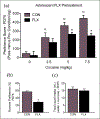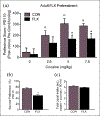Fluoxetine exposure in adolescent and adult female mice decreases cocaine and sucrose preference later in life
- PMID: 30334670
- PMCID: PMC6472984
- DOI: 10.1177/0269881118805488
Fluoxetine exposure in adolescent and adult female mice decreases cocaine and sucrose preference later in life
Abstract
Background: Preclinical evidence from male subjects indicates that exposure to psychotropic medications, during early development, results in long-lasting altered responses to reward-related stimuli. However, it is not known if exposure to the antidepressant fluoxetine, in female subjects specifically, changes sensitivity to natural and drug rewards, later in life.
Aims: The aim of this work was to investigate if exposure to fluoxetine mediates enduring changes in sensitivity to the rewarding properties of cocaine and sucrose, using female mice as a model system.
Methods: We exposed C57BL/6 female mice to fluoxetine (250 mg/L in their drinking water) for 15 consecutive days, either during adolescence (postnatal day 35-49) or adulthood (postnatal day 70-84). Twenty-one days later, mice were examined on their behavioral reactivity to cocaine (0, 2.5, 5, 7.5 mg/kg) using the conditioned place preference paradigm, or assessed on the two-bottle sucrose (1%) test.
Results: We found that regardless of age of antidepressant exposure, female mice pre-exposed to fluoxetine displayed reliable conditioning to the cocaine-paired compartment. However, when compared to respective age-matched controls, antidepressant pre-exposure decreased the magnitude of conditioning at the 5 and 7.5 mg/kg cocaine doses. Furthermore, fluoxetine pre-exposure reduced sucrose preference without altering total liquid intake.
Conclusions: The data suggest that pre-exposure to fluoxetine, during adolescence or adulthood, results in a prolonged decrease in sensitivity to the rewarding properties of both natural and drug rewards in female C57BL/6 mice.
Keywords: Anhedonia; C57BL/6; conditioned place preference; juvenile; reward; selective serotonin reuptake inhibitor.
Conflict of interest statement
Declaration of conflicting interest
The author(s) declared no potential conflicts of interest with respect to the research, authorship, and/or publication of this article.
Figures






Similar articles
-
Fluoxetine exposure during adolescence increases preference for cocaine in adulthood.Sci Rep. 2015 Oct 9;5:15009. doi: 10.1038/srep15009. Sci Rep. 2015. PMID: 26449406 Free PMC article.
-
Enduring effects of adolescent ketamine exposure on cocaine- and sucrose-induced reward in male and female C57BL/6 mice.Neuropsychopharmacology. 2020 Aug;45(9):1536-1544. doi: 10.1038/s41386-020-0654-7. Epub 2020 Mar 12. Neuropsychopharmacology. 2020. PMID: 32165718 Free PMC article.
-
Long-term, low-level adolescent nicotine exposure produces dose-dependent changes in cocaine sensitivity and reward in adult mice.Int J Dev Neurosci. 2004 Aug-Oct;22(5-6):339-48. doi: 10.1016/j.ijdevneu.2004.04.002. Int J Dev Neurosci. 2004. PMID: 15380833
-
Sex differences in the long-lasting consequences of adolescent ethanol exposure for the rewarding effects of cocaine in mice.Psychopharmacology (Berl). 2015 Aug;232(16):2995-3007. doi: 10.1007/s00213-015-3937-7. Epub 2015 May 6. Psychopharmacology (Berl). 2015. PMID: 25943165
-
Repeated exposure to cocaine during adolescence enhances the rewarding threshold for cocaine-conditioned place preference in adulthood.Addict Biol. 2021 Sep;26(5):e13012. doi: 10.1111/adb.13012. Epub 2021 Jan 28. Addict Biol. 2021. PMID: 33511707
Cited by
-
Effect of early-life stress or fluoxetine exposure on later-life conditioned taste aversion learning in Sprague-Dawley rats.Neurosci Lett. 2022 Sep 14;787:136818. doi: 10.1016/j.neulet.2022.136818. Epub 2022 Aug 2. Neurosci Lett. 2022. PMID: 35931277 Free PMC article.
-
Early-life ketamine exposure attenuates the preference for ethanol in adolescent Sprague-Dawley rats.Behav Brain Res. 2020 Jul 1;389:112626. doi: 10.1016/j.bbr.2020.112626. Epub 2020 Apr 30. Behav Brain Res. 2020. PMID: 32361040 Free PMC article.
-
Upregulation of hippocampal extracellular signal-regulated kinase (ERK)-2 induces antidepressant-like behavior in the rat forced swim test.Behav Neurosci. 2019 Apr;133(2):225-231. doi: 10.1037/bne0000303. Behav Neurosci. 2019. PMID: 30907619 Free PMC article.
-
Autophagy Induction and Accumulation of Phosphorylated Tau in the Hippocampus and Prefrontal Cortex of Adult C57BL/6 Mice Subjected to Adolescent Fluoxetine Treatment.J Alzheimers Dis. 2021;83(4):1691-1702. doi: 10.3233/JAD-210475. J Alzheimers Dis. 2021. PMID: 34420960 Free PMC article.
-
Sex-Specific Alterations in Spatial Memory and Hippocampal AKT-mTOR Signaling in Adult Mice Pre-exposed to Ketamine and/or Psychological Stress During Adolescence.Biol Psychiatry Glob Open Sci. 2023 Aug 10;4(1):240-251. doi: 10.1016/j.bpsgos.2023.07.009. eCollection 2024 Jan. Biol Psychiatry Glob Open Sci. 2023. PMID: 38298791 Free PMC article.
References
-
- Airan RD, Meltzer LA, Roy M, et al. (2007) High-speed imaging reveals neurophysiological links to behavior in an animal model of depression. Science 317: 819–823. - PubMed
-
- Anderson GD (2005) Sex and racial differences in pharmacological response: Where is the evidence? Pharmacogenetics, pharmacokinetics, and pharmacodynamics. J Womens Health (Larchmt) 14: 19–29. - PubMed
Grants and funding
LinkOut - more resources
Full Text Sources

